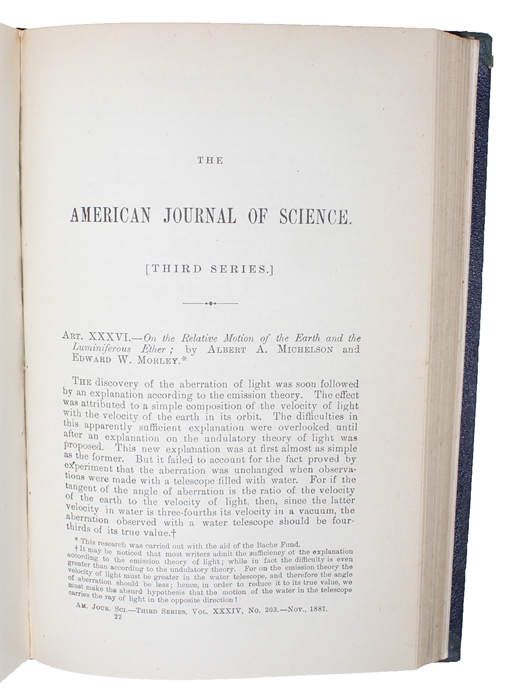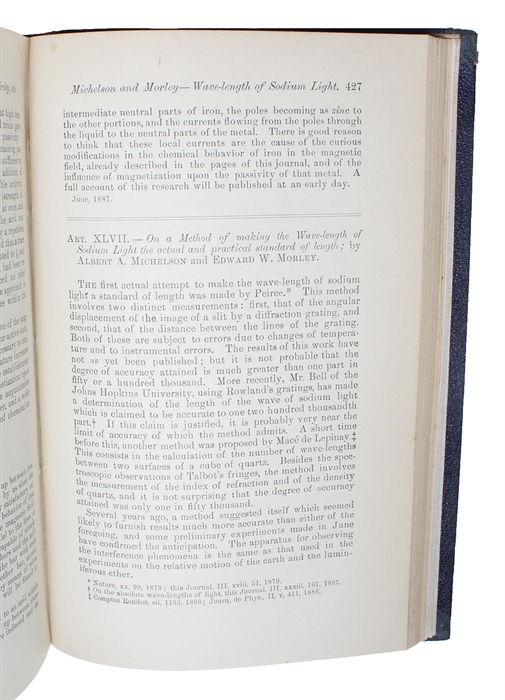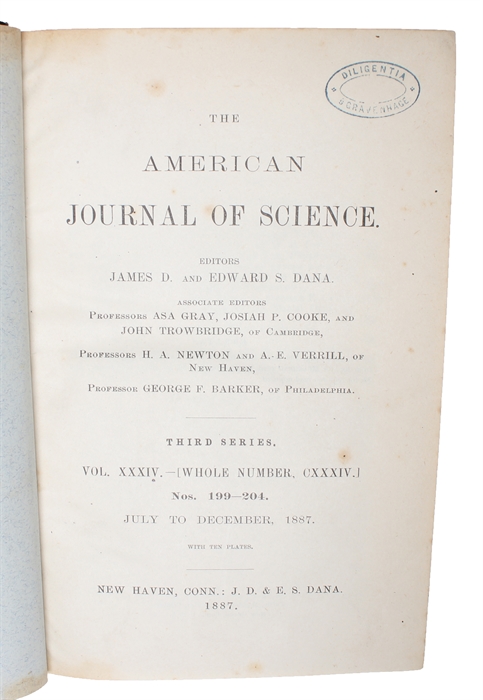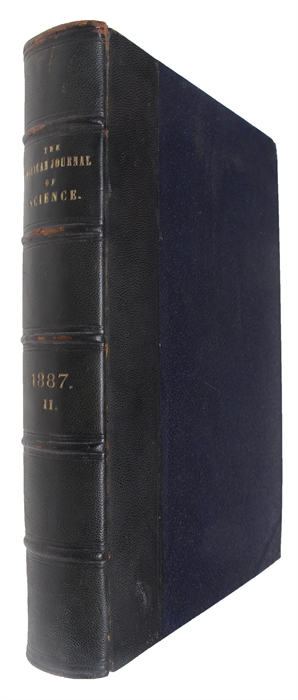MICHELSON, ALBERT A. & EDWARD W. MORLEY - THE MICHELSON-MORLEY EXPERIMENT, THE ETHER DRAG.
On the Relative Motion of the Earth and the Luminiferous Ether.
New Haven, Conn., J.D. & E.S. Dana, 1887.
8vo. Contemporary half calf. Gilt lettering to spine. A small stamp to top of title-page. In: "The American Journal of Science. Editors James D. and Edward S. Dana", Third series Vol. XXXIV (July to December, 1887). VIII,500 pp., textillustr. and 10 plates. (Entire volume offered). The joint paper: pp. 333-345 and textillustr. (Apparatus). A few faint brownspots to titlepage, otherwise clean and fine.
First appearance of this classic paper which announced one of the most celebrated experiments in the history of physics and eventually led Einstein to his Relativity Theory.The experiment was expected to show the rate of the earth's movement through the ether; they looked in vain for a difference between the speed of light in the direction of the earth's motion around the sun and the direction perpendicular to it. The failure of this experiment was a serious blow to classical scientific theories because it cast doubts on the existance of the universal ether which had been a basic principleof, for example, the Newtonian theories of the universe. (Vide PMM: 378, 401, 408).
The paper appeared first in the "American Journal of Science" in November (as offered here), and was published a month later in "Philosophical Magazine" in a slightly modified form.
"Michelson, trained at the U.S. Naval Academy, and Morley, minister turned chemist, began a series of experiments to determine the relation of ether drift and the velocity of light, effects of extremely minute values. They used a slightly silvered glass set angular to a ray of sunlight so that a part ofthe ray was transmitted, a part reflected out and again returned, thereby providing two paths, one perpendicular to the other. If drift existed, the superimposed rays would produce interference. None was observed, showing that the earth's motion did not affect the light's speed. The negative result held revolutionary implications which led directly thru Lorentz and Einstein to the acceptance of new standards of reference of time and space from geometry and cosmometry."(Dibner)
In 1919 Einstein met Michelson in California. At a dinner given in honor of them both, Einstein said in a speech "You (Michelson) uncovered an insidious defect in the ether theory of light, as it existed, and stimulated the ideas of H.A. Lorentz and Fitzgerald, out of which the Special Theory of Relativity developed. Without your work this theory would today be scarcely more than an interesting speculation..." In an interview in 1842 Einstein said: "It is no doubt that Michelson's experiment was of considerably influence upon my work insofar as it strengthened my conviction concerning the validity of the Principle of relativity...On the other side I was pretty much convinced of the validity of the principle before I did know this experiment and its result. In any case, Michelson's experiment removed practically any doubt about the validity of the principle in optics and showed that a profound change of the basic concepts of physics was inevitable."
Michelson was awarded the 1907 Nobel Prize "for his optical precision instrument (the inteferometer) and the spectroscopic and metrological investigations he has carried on."
Dibner: Heralds of Science: 161 (lising the later version from "Philosophical Magazine") - Norman 1505.- Magee "A Source Book in Physics", pp. 369 ff. (the later paper).
The volume contains another paper by Michelson and Morley "On a method of Making the Wave-lenght of Sodium Light the actual and practical Standard of Lenght", pp. 427-430.
Order-nr.: 47165




